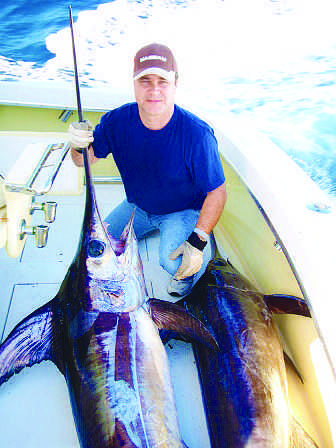Catching Swordfish Off Southeast Florida
Capt. Jimbo Thomas
The calm seas of late summer are really a boon to swordfishermen because they can fish almost every day. I’ve caught swordfish every month of the year, but we probably catch more in the summer months because the weather is more consistent for fishing offshore. As a rule, the areas we like to fish are about 16 miles offshore in 1,600 to 2,000 feet of water.
Off Miami, there’s a big ledge that we fish called the Miami Terrace. We like to work the bottom or deeper side of the ledge, which is in about 1,800 feet of water. You can fish up on the ledge, but you risk catching bottom. The ledge drops off quickly, so the difference between 1,500 feet of water and 2,000 feet of water is about 500 yards, so you have to watch the bottom closely at all times or you can drive up onto the ledge with the current. If your bait is down in 1,800 or 1,900 feet of water and you drift up to 1,500 feet, you’ll likely get hung up on the bottom and lose all your gear.
Farther north off Ft. Lauderdale, you’ll fish the same depths, but it is more flat on the bottom there, so you don’t have the same risk of getting hung up in the bottom. The guys fishing off Hillsborough, Pompano and Boynton Beach are running out to that same depth and putting their baits on the bottom and just drifting along. I use bonito strips a lot, but squid works well, as does mackerel, bluefish and even dolphin bellies. They’re not very selective.
Whatever we use for bait, we place a glow skirt on top of it to help the fish find it. We use a 300-pound leader with either a single or double 1/0-12/0 hooks. We use the standard “J” style hooks instead of circle hooks. We’ll put a light about 10 feet above the bait and a second light 40 feet up from the bait. The entire leader from the hook to the sinker is about 100 feet long.
We prefer to use electric reels and up to 20 pounds of weight depending on how hard the current is running. We’ll get on top of the spot, drop the bait and put the boat in gear while the lead sinks the bait to the bottom, then drift back on top of it and come tight. Then we’ll reel it up about 100 feet, so the bait is hanging below the weight and just above the bottom. Swordfish will come off the bottom. We’ve caught them 500 feet off the bottom before, but the majority of fish are pretty close to the bottom.
Once the bait is set, we’ll just drift along and watch the rod tip. The bite is really soft with that much line out. You might see the rod tip bounce a couple of times or it might just even go slack. If you see that, reel. As soon as the fish bites and feels that something wrong, they want to jump, so they immediately head for the surface, and all that weight sets the hook for you. A lot of times you’re not even sure if you have a fish on, as you reel in slack line while the fish heads for the surface, but once they get to about 300 feet of water they usually put on the breaks and start fighting—either that or they come to the surface and jump.
You don’t know if you have a 50-pounder or a 500-pounder until the fish gets to the point it finally wants to start fighting. It may run deep, run away from the boat or jump, but once it starts to figure out it’s hooked, you’ll know pretty quickly if it’s a large fish or not. We use 80-pound braided line, but a lot of guys use heavier and recently I’ve seen a number of anglers going lighter to 60-pound braided line because of the decrease in friction in the water. The thinner the diameter the line, the easier it is to get your bait down to the bottom and the less drag it has in the water when you’re fighting fish. Swordfish have soft mouths, and it’s not uncommon to pull the hook out on them—particularly after a long fight when the hook has worn a big hole in the fish’s jaw. You have to keep the line tight at all times, or the hook will just fall out, and the fish will get away.

